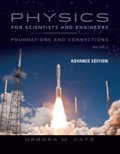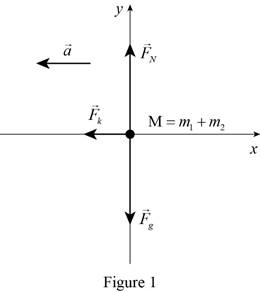
The velocity of the system just after the collision using Newton’s second law and the comparison of the answer with the result of Example 11.4.
Answer to Problem 32PQ
The velocity of the system just after the collision using Newton’s second law is
Explanation of Solution
The free-body diagram of the system is shown in figure 1.

The two-train system only moves in
Write the expression for the Newton’s second law in
Here,
Refer to figure 1. The only force acting in
Write the equation for
Here,
Put the above equation in equation (I).
The kinetic friction is proportional to the normal force and the normal force is in turn equal to the weight of the train.
Write the expression for
Here,
Write the equation for
Here,
Put the above equation in equation (III).
Put the above equation in equation (II) and rewrite it for
Initially only the freight train has momentum. Assume that the two trains move together with velocity
Here,
Rewrite the above equation for
Now consider the motion of the system just after the collision to the moment it comes to rest.
Replace
The speed of the two-train system as it comes to rest is zero.
Write the expression for the final speed of the system as it comes to rest.
Here,
Write the constant-acceleration equation of motion.
Here,
Put equations (IV) to (VI) in the above equation and rewrite it for
To find the range of possible initial freight train velocities, the extreme values of the coefficient of kinetic friction must be used.
Write the equation for
Here,
Conclusion:
Given that the value of
Substitute
Substitute
Here,
The system moves in
Here,
Substitute
Substitute
Here,
It is given that the train crosses the red signal at a speed of
Since the train passed the red signal with the speed of
Write the expression for the maximum velocity of the system.
Here,
Substitute
The range of the speed of the two-train system is
Therefore, the velocity of the system just after the collision using Newton’s second law is
Want to see more full solutions like this?
Chapter 11 Solutions
EBK PHYSICS FOR SCIENTISTS AND ENGINEER
- Required information The leg bone (femur) breaks under a compressive force of about 6.50 × 104 N for a human and 12.3 × 104 N for a horse. The human femur has a compressive strength of 160 MPa, whereas the horse femur has a compressive strength of 140 MPa. What is the effective cross-sectional area of the femur in a horse? (Note: Since the center of the femur contains bone marrow, which has essentially no compressive strength, the effective cross-sectional area is about 80% of the total cross-sectional area.) cm2arrow_forwardno ai pleasearrow_forwardA block of mass m₁ = 1.85 kg and a block of mass m₂ is 0.360 for both blocks. = m M, R m2 Ꮎ 5.90 kg are connected by a massless string over a pulley in the shape of a solid disk having a mass of M = 10.0 kg. The fixed, wedge-shaped ramp makes an angle of 0 = 30.0° as shown in the figure. The coefficient of kinetic friction (a) Determine the acceleration of the two blocks. (Enter the magnitude of the acceleration.) x m/s² (b) Determine the tensions in the string on both sides of the pulley. left of the pulley × N right of the pulley X N Enter a number.arrow_forward
- What is the error determined by the 2/3 rule?arrow_forwardYour colleague gives you a sample that are supposed to consist of Pt-Ni nanoparticles, TiO2 nanorod arrays, and SiO2 monolith plates (see right panel schematic). The bimetallic Pt-Ni nanoparticles are expected to decorate on the side surfaces of the aligned TiO2 nanorod arrays. These aligned TiO2 nanoarrays grew on the flat SiO2 monolith. Let's assume that the sizes of the Pt-Ni nanoparticles are > 10 nm. We further assume that you have access to a modern SEM that can produce a probe size as small as 1 nm with a current as high as 1 nA. You are not expected to damage/destroy the sample. Hint: keep your answers concise and to the point. TiO₂ Nanorods SiO, monolith a) What do you plan to do if your colleague wants to know if the Pt and Ni formed uniform alloy nanoparticles? (5 points) b) If your colleague wants to know the spatial distribution of the PtNi nanoparticles with respect to the TiO2 nanoarrays, how do you accomplish such a goal? (5 points) c) Based on the experimental results…arrow_forwardFind the current in 5.00 and 7.00 Ω resistors. Please explain all reasoningarrow_forward
- Find the amplitude, wavelength, period, and the speed of the wave.arrow_forwardA long solenoid of length 6.70 × 10-2 m and cross-sectional area 5.0 × 10-5 m² contains 6500 turns per meter of length. Determine the emf induced in the solenoid when the current in the solenoid changes from 0 to 1.5 A during the time interval from 0 to 0.20 s. Number Unitsarrow_forwardA coat hanger of mass m = 0.255 kg oscillates on a peg as a physical pendulum as shown in the figure below. The distance from the pivot to the center of mass of the coat hanger is d = 18.0 cm and the period of the motion is T = 1.37 s. Find the moment of inertia of the coat hanger about the pivot.arrow_forward
- Review Conceptual Example 3 and the drawing as an aid in solving this problem. A conducting rod slides down between two frictionless vertical copper tracks at a constant speed of 3.9 m/s perpendicular to a 0.49-T magnetic field. The resistance of th rod and tracks is negligible. The rod maintains electrical contact with the tracks at all times and has a length of 1.4 m. A 1.1-Q resistor is attached between the tops of the tracks. (a) What is the mass of the rod? (b) Find the change in the gravitational potentia energy that occurs in a time of 0.26 s. (c) Find the electrical energy dissipated in the resistor in 0.26 s.arrow_forwardA camera lens used for taking close-up photographs has a focal length of 21.5 mm. The farthest it can be placed from the film is 34.0 mm. (a) What is the closest object (in mm) that can be photographed? 58.5 mm (b) What is the magnification of this closest object? 0.581 × ×arrow_forwardGiven two particles with Q = 4.40-µC charges as shown in the figure below and a particle with charge q = 1.40 ✕ 10−18 C at the origin. (Note: Assume a reference level of potential V = 0 at r = ∞.) Three positively charged particles lie along the x-axis of the x y coordinate plane.Charge q is at the origin.Charge Q is at (0.800 m, 0).Another charge Q is at (−0.800 m, 0).(a)What is the net force (in N) exerted by the two 4.40-µC charges on the charge q? (Enter the magnitude.) N(b)What is the electric field (in N/C) at the origin due to the two 4.40-µC particles? (Enter the magnitude.) N/C(c)What is the electrical potential (in kV) at the origin due to the two 4.40-µC particles? kV(d)What If? What would be the change in electric potential energy (in J) of the system if the charge q were moved a distance d = 0.400 m closer to either of the 4.40-µC particles?arrow_forward
 Physics for Scientists and Engineers: Foundations...PhysicsISBN:9781133939146Author:Katz, Debora M.Publisher:Cengage Learning
Physics for Scientists and Engineers: Foundations...PhysicsISBN:9781133939146Author:Katz, Debora M.Publisher:Cengage Learning Principles of Physics: A Calculus-Based TextPhysicsISBN:9781133104261Author:Raymond A. Serway, John W. JewettPublisher:Cengage Learning
Principles of Physics: A Calculus-Based TextPhysicsISBN:9781133104261Author:Raymond A. Serway, John W. JewettPublisher:Cengage Learning University Physics Volume 1PhysicsISBN:9781938168277Author:William Moebs, Samuel J. Ling, Jeff SannyPublisher:OpenStax - Rice University
University Physics Volume 1PhysicsISBN:9781938168277Author:William Moebs, Samuel J. Ling, Jeff SannyPublisher:OpenStax - Rice University Physics for Scientists and Engineers with Modern ...PhysicsISBN:9781337553292Author:Raymond A. Serway, John W. JewettPublisher:Cengage Learning
Physics for Scientists and Engineers with Modern ...PhysicsISBN:9781337553292Author:Raymond A. Serway, John W. JewettPublisher:Cengage Learning College PhysicsPhysicsISBN:9781938168000Author:Paul Peter Urone, Roger HinrichsPublisher:OpenStax College
College PhysicsPhysicsISBN:9781938168000Author:Paul Peter Urone, Roger HinrichsPublisher:OpenStax College Physics for Scientists and Engineers, Technology ...PhysicsISBN:9781305116399Author:Raymond A. Serway, John W. JewettPublisher:Cengage Learning
Physics for Scientists and Engineers, Technology ...PhysicsISBN:9781305116399Author:Raymond A. Serway, John W. JewettPublisher:Cengage Learning





